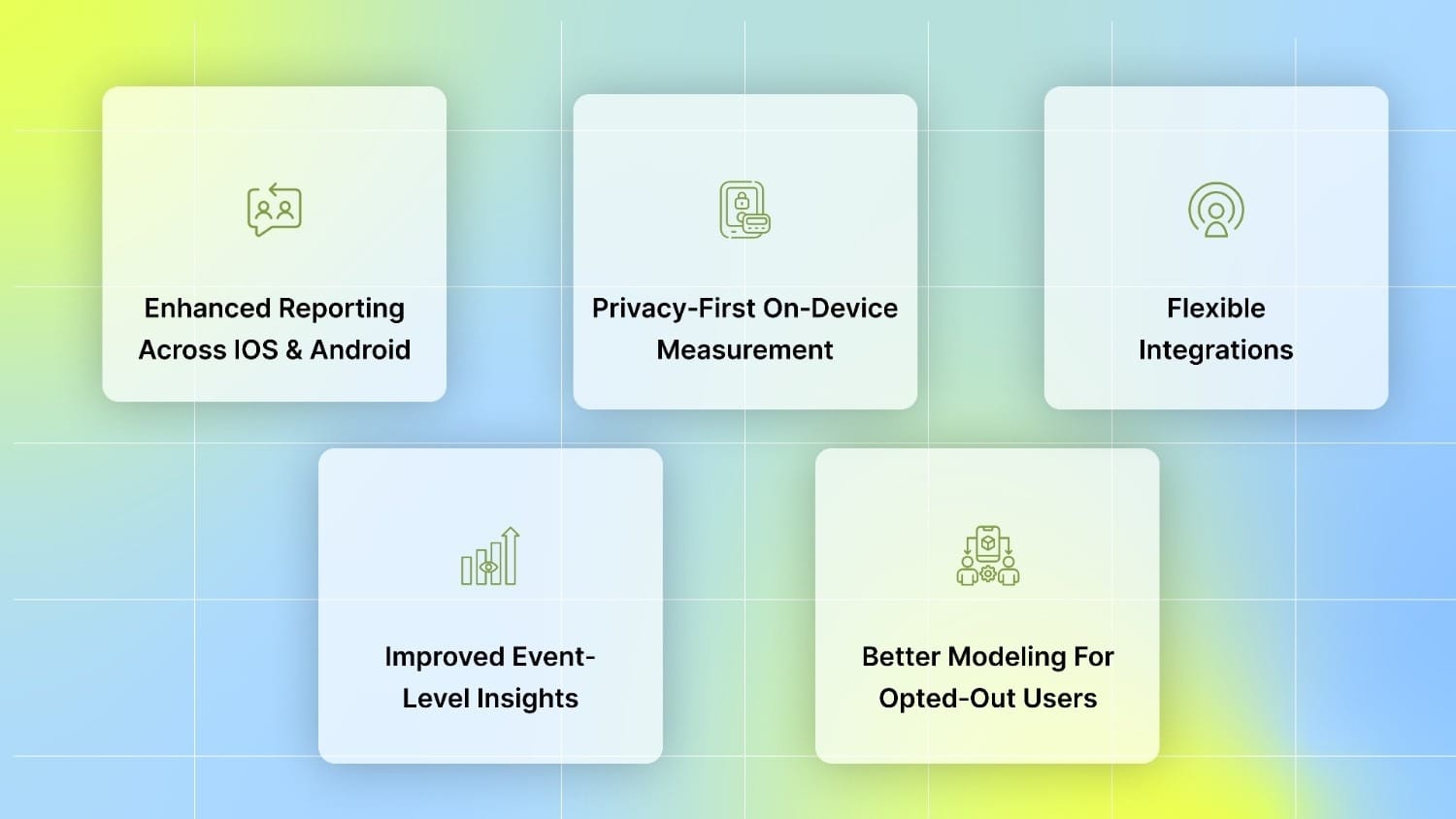Google’s Integrated Conversion Measurement (ICM): Smarter Attribution for App Campaigns
Tracking conversions accurately has never been more challenging. With Apple’s App Tracking Transparency (ATT), third-party cookie deprecation, and tightening global privacy laws, performance marketers are losing visibility into how users engage and convert across platforms. The result? Incomplete attribution, unstable ROAS, and growing uncertainty in user acquisition strategies.
To put the challenge in perspective, nearly 96% of U.S. iOS users opt out of tracking under ATT, costing marketers an estimated $10 billion in lost ad value. Clearly, traditional attribution models can’t keep up in a privacy-first world.
That’s why Google introduced Integrated Conversion Measurement (ICM): a new, privacy-safe, and completely risk-free framework that restores visibility into app performance without compromising user trust. In this blog, we’ll break down what ICM is, how it works, and the benefits it offers.
Key Takeaways
ICM restores lost visibility in a privacy-first world. It provides performance marketers with accurate, event-level data across iOS and Android, even in the face of identifier loss, enabling you to make more informed decisions.
Privacy and compliance are built in. With on-device measurement and aggregated reporting, you get actionable insights without compromising user trust.
Flexible and easy to adopt. ICM integrates with your existing MMPs or CDPs, and Android campaigns require no extra setup to start benefiting from improved attribution
What is Google’s Integrated Conversion Measurement (ICM)?
ICM is Google’s new attribution protocol designed specifically for app campaigns. It brings conversion signals directly into your Mobile Measurement Partner (MMP) dashboards in a privacy‑safe way. This process works even when user identifiers are unavailable.
For DTC brands that have mobile apps, MMPs like Adjust are typically used. It uses on-device measurement, probabilistic modeling, and event-level reporting to fill attribution gaps. This is especially useful for iOS users who opt out of tracking and Android users in restricted regions. By doing so, ICM helps you understand which ad interactions actually led to installs, without compromising user privacy.
This data shows which app campaigns are most effective in converting users. However, to act on it, you need creative-level insights, such as the hooks, visuals, or formats that truly drive results. That’s where Segwise comes into play. With tag-level performance optimization, you can see which creative elements, themes, and formats drive results across all your campaigns and apps.
Now that you understand what ICM is, let’s look at the key benefits it offers.
Also Read: Understanding ROAS in Google Ads: A Simple Guide
Benefits of using Integrated Conversion Measurement
Using ICM means you don’t have to live with the blind spots in your conversion data. You gain stronger cross‑device insight and more reliable performance tracking. Whether you're scaling mobile game installs, DTC app conversions, or subscription sign-ups, ICM provides the extra signal clarity you need to make smarter UA decisions.

Here are key benefits for your app campaigns to boost performance:
Enhanced reporting across iOS & Android
Enables instant and event-level reporting of your campaign performance. On iOS, advertisers will receive improved reporting for app conversions from iOS 14+ and later users. On Android, advertisers will get better reporting for app conversions from the European Economic Area (EEA) or when a user opts out of device-level permissions.
Privacy‑First On‑Device Measurement
Incorporates innovative technologies, such as on-device conversion measurement, to enhance measurement accuracy. Conversion signals are processed locally on the user’s device and then aggregated before reporting, ensuring compliance with privacy rules. This means you don’t have to choose between measurement and user trust.
Flexible Integrations
Seamlessly integrates with third-party apps or platforms using Google’s App Conversion Tracking API, if the partner (MMP or attribution system) supports ICM / the App Conversion Tracking API. This makes it adaptable across various app attribution workflows.
Improved Event-Level Insights
Instead of seeing just aggregated stats, you’ll be able to tie specific events (like signups, purchases) back to ad interactions. This deeper granularity enables you to enhance campaign optimization and reporting.
Better Modeling for Opted‑Out Users
Even when users decline tracking (for example, under ATT), ICM uses probabilistic modeling to estimate attribution with confidence. You recover insight into previously dark cohorts and reduce bias in your optimization decisions.
In short, ICM helps you see the full picture of your ad performance without compromising user privacy. It gives you the deep insights you need to make faster, data-driven decisions with confidence.
Now that you know the benefits of ICM, let’s look at what you need to get started.
Eligibility requirements to get started
Before you start using ICM, it’s essential to verify that your setup is ready. The process looks slightly different for iOS and Android. To enable this solution, follow the steps below:
For iOS App Campaigns
If you run campaigns on iOS, you’ll need to follow a few setup steps before ICM can begin collecting conversion data:
Have an active iOS App campaign for installs on Google Ads. This ensures Google can start connecting your ad engagement data with post-install conversions coming from your MMP.
Implement on-device conversion measurement using event data. This means that your conversion signals will be measured securely on the device, ensuring user privacy remains intact.
Update to the latest version of your third-party App Attribution Partner SDK. Ensure you’re using the latest SDK version. Some partners may roll out support at different times, so check their documentation or reach out directly for timelines.
If you’re using a server-to-server integration, you’ll need to pass the on-device measurement “info” string from your app to your attribution partner. This step ensures your conversion data is processed correctly under the ICM framework.
For Android App Campaigns
If you’re running campaigns for Android apps, you don’t need to take any manual steps to enable ICM. While Android doesn’t require manual setup, the MMP still needs to support and integrate ICM. Make sure your partner (MMP) has ICM support enabled.
Measurement improvements will roll out automatically through your connected App Attribution Partner once they support the new integration. That means you’ll start benefiting from enhanced accuracy and cross-device tracking with no additional setup.
Getting ICM enabled is about protecting your campaign visibility in a privacy-restricted world. Make sure your iOS and Android setups meet the requirements. This gives you cleaner, more reliable conversion data. It helps you boost ROAS across channels.
With attribution data, the next step is turning that data into actionable creative insights.
Also Read: Top Mobile Measurement Partners (MMPs) in 2025
How Segwise Turns ICM Data Into Creative Performance Insights
Once ICM is active, you’ll gain clearer visibility into which app campaigns drive conversions, but that’s only half the story. Knowing why those campaigns perform well requires creative-level insight. That’s where Segwise adds unique value.
Segwise is an AI-powered creative analytics platform built to turn attribution data from Google Ads and other networks into actionable insights. It analyzes the creative drivers behind your performance metrics, so you can connect every conversion back to the visuals, messages, and calls-to-action that made it happen.
Here’s how Segwise complements ICM:
1. AI-Based Creative Tagging
Automatically identifies and tags creative elements such as hooks, characters, CTAs, and colors across images, videos, and playables. This helps you link ICM-tracked conversions to specific creative traits that drive IPM, CTR, and ROAS.
2. Smart Tag Extraction from Naming Conventions
Segwise reads your existing file names and naming structures to generate consistent creative tags without altering your current workflow.
3. Tag-Level Performance Insights
Goes beyond campaign averages to reveal which creative themes, styles, or CTAs are delivering the strongest conversion outcomes reported through ICM.
4. Creative Fatigue Detection
Tracks how engagement metrics evolve over time and alerts you to declining performance, helping you refresh creatives before efficiency drops.
5. Adaptive Dashboards and Reports
Visualizes how creative decisions affect ROAS and conversion volume across networks. With ICM’s enhanced data feeding into Segwise, you get a complete picture of what’s working, not just in measurement, but in creative execution.
ICM strengthens attribution. Segwise makes that attribution meaningful by uncovering the creative and messaging levers behind every result. Together, they close the loop between accurate measurement and effective optimization in a privacy-first world.
Conclusion
ICM provides performance marketers with a much-needed upgrade in attribution, restoring visibility into installs without compromising user privacy. With stronger cross-platform tracking and privacy-first measurement, it closes major data gaps caused by signal loss while ensuring campaign insights remain accurate and compliant.
If you want to convert attribution data into more detailed insights, Segwise helps you identify which hooks, visuals, CTAs, and formats are truly driving conversions. Its AI agents automatically tag creative elements across images, video, playables, and text to highlight what works. With seamless, no-code integration into your ad stack, Segwise quickly surfaces tag-level performance optimization, helping you iterate faster and allocate budget to winning assets.
So, why wait? Start your 14-day free trial today and see how creative insights can power your next level of growth.
FAQs
1. Does ICM replace SKAdNetwork or modeling?
No. ICM complements SKAdNetwork and conversion modeling. It provides more event-level visibility in privacy-challenged environments, but combining all methods yields better coverage.
2. Are there limitations or trade-offs with ICM?
Yes. Because some attribution is modeled or probabilistic, there may be estimation error. Also, some conversion events may not be captured immediately, and coverage depends on partner support.
3. Does ICM work only for installs or also for post-install events?
ICM is designed to provide event-level insight, so it can include post-install events; however, support and visibility for those depend on how your MMP implements ICM.
4. Will ICM work for re-attributed installs (users who uninstall then reinstall via ads)?
Yes. ICM supports re-attributions by sending verified install claims even when user identifiers are missing, allowing supported partners to attribute reinstalls accurately.
5. What is “probabilistic attribution” in ICM?
That means when deterministic identifiers (such as device IDs) are unavailable, Google uses modeling or statistical inference to attribute installs or events from ad clicks. It only reports such data when confidence is high.

Comments
Your comment has been submitted successfully!